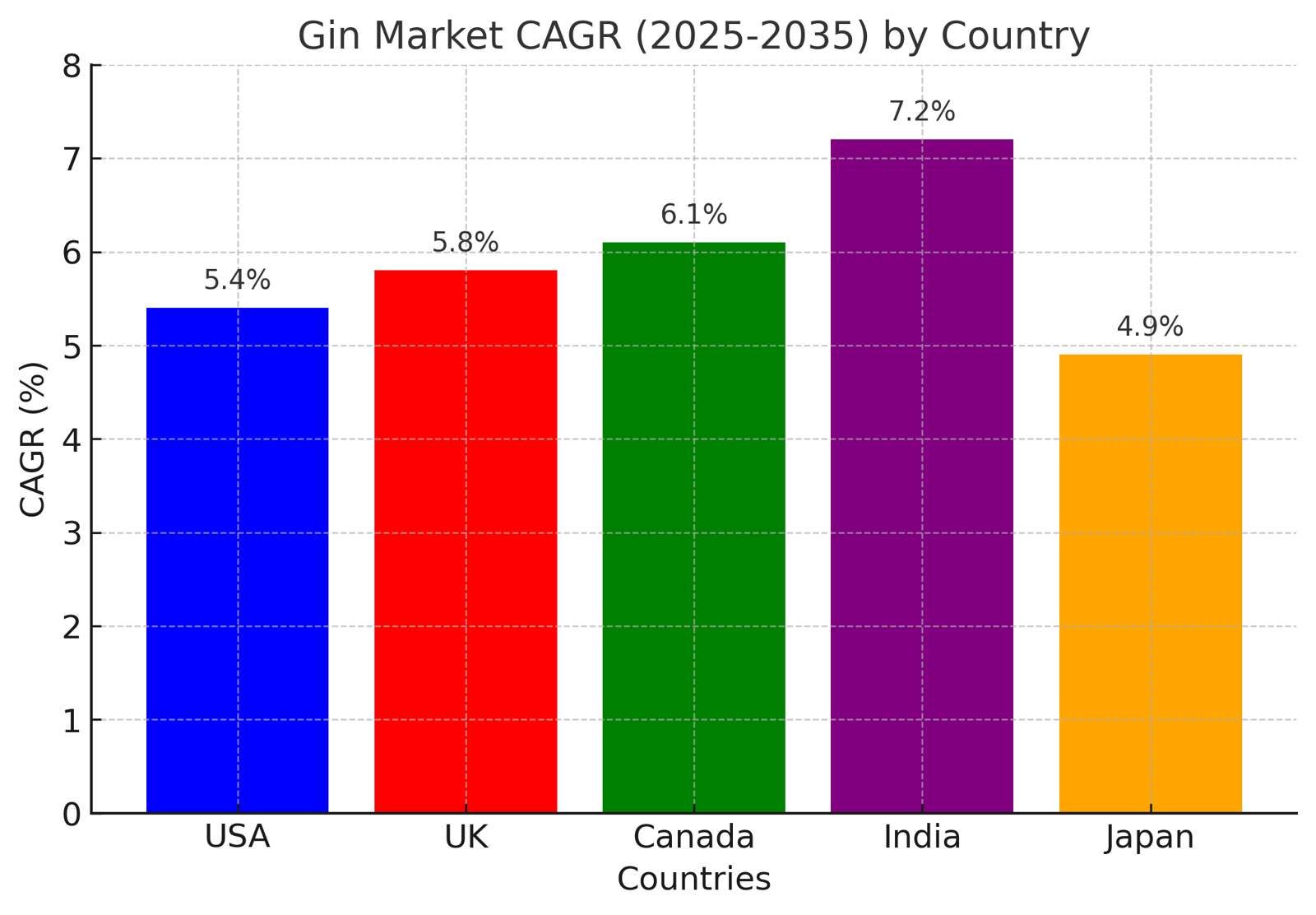
The global gin market is set for steady growth, with projections indicating a compound annual growth rate (CAGR) of 3.8% during the forecast period. The market is expected to generate revenues of USD 24.4 billion by 2025 and USD 34.5 billion by 2035, driven by evolving consumer preferences and rising demand for premium spirits.
The future of the gin industry appears promising, with market demand expected to rise steadily. Factors such as increasing disposable incomes, urbanization, and a growing preference for premium alcoholic beverages are contributing to this upward trend. Additionally, the advent of low-alcohol and non-alcoholic gin alternatives caters to health-conscious consumers, further broadening the market base.
Explore Key Insights – Request Your Sample Now! https://www.futuremarketinsights.com/reports/sample/rep-in-1074
Key Drivers and Challenges in the Global Gin Market
Several key drivers are influencing the growth of the global gin market:
Premiumization: Consumers are gravitating towards high-quality, premium gin offerings, willing to pay a premium for superior taste and unique botanicals.
Craft Distilling: The rise of craft distilleries has introduced innovative flavors and localized gin variants, attracting adventurous consumers seeking novel experiences.
Cocktail Culture: The popularity of gin-based cocktails has surged, with mixologists experimenting with diverse ingredients, making gin a versatile choice in bars and restaurants.
However, the industry faces challenges such as stringent regulatory frameworks, fluctuating raw material prices, and competition from other spirits like tequila and whiskey. Additionally, consumers are becoming cautious of artificially flavored products, prompting a shift towards authentic and natural botanicals.
Industry Developments
Gin brands are expanding portfolios with new botanical flavors, catering to consumer demand for unique taste experiences.
Distilleries are investing in sustainable production practices, including reduced water usage and eco-friendly packaging.
Collaborations between gin producers and mixologists are driving innovation in cocktails and craft spirits.
Consumer Preferences and Trends Shaping the Gin Market
Modern consumers exhibit a penchant for authenticity, sustainability, and unique flavor profiles. There is a growing inclination towards gins infused with exotic botanicals and locally sourced ingredients. Moreover, environmentally conscious consumers are driving demand for sustainably produced gins, prompting distilleries to adopt eco-friendly practices.
Impact of Premiumization on Global Gin Industry Growth
Premiumization has significantly impacted the gin industry, with consumers associating higher quality with superior taste and exclusivity. This trend has led to an increase in premium gin offerings, contributing to higher profit margins for producers and retailers alike. Premium gins often feature unique botanicals and artisanal production methods, appealing to discerning consumers.
Craft Gin Market Opportunities and Expansion Strategies
The craft gin segment presents ample opportunities for growth. Craft distilleries are capitalizing on consumer desires for personalized and locally produced spirits. Strategies such as storytelling, limited edition releases, and collaborations with local artisans have proven effective in capturing market share. Additionally, experiential marketing, including distillery tours and gin-tasting events, enhances consumer engagement and brand loyalty.
Alcohol Industry Trends and the Rising Popularity of Gin
Within the broader alcohol industry, gin has emerged as a versatile and fashionable choice. Its adaptability in cocktails and the resurgence of classic gin-based drinks have contributed to its rising popularity. Furthermore, the global trend towards premiumization in the alcohol sector aligns with the growth observed in the gin market.
Sustainability and Innovation in the Gin Manufacturing Industry
Sustainability and innovation are at the forefront of the gin manufacturing industry. Distilleries are implementing eco-friendly practices such as carbon-neutral distillation and regenerative agriculture. Innovations in flavor development, including AI-based formulations, are enabling producers to cater to evolving consumer tastes while maintaining environmental responsibility.
Unlock Comprehensive Insights – Get the Full Report Now: https://www.futuremarketinsights.com/reports/gin-market
Regional Insights
The gin market is experiencing notable growth across key regions, with emerging markets showing promising potential.
USA
The growing demand for premium craft gin and the rising popularity of ready-to-drink (RTD) cocktails are driving industry growth in the U.S. Consumers are shifting away from traditional gin and tonic pairings toward canned gin cocktails infused with exotic botanicals and natural fruits.
Craft distillers are innovating with barrel-aging techniques, terroir-infused botanicals, and functional ingredient infusions to create ultra-premium, limited-release gins. Super-premium and craft styles are expected to lead the market by 2035, catering to the booming cocktail culture and mixology trends. FMI predicts that the U.S. gin industry will grow at a 5.4% CAGR during the forecast period.
UK
The UK remains a leader in the gin industry, with sustainability becoming a defining factor. Distilleries are shifting towards locally grown botanicals and sustainable production methods. Historically reliant on imported juniper and herbs, the industry is now embracing regenerative agricultural practices to preserve biodiversity.
Canada
Canada’s gin industry is evolving beyond traditional styles, with a growing focus on terroir and Arctic botanical-infused gins. Consumers are gravitating toward hyper-local sourcing and seasonal ingredients like Labrador tea, spruce tips, and wild juniper berries.
Barrel-rested and cask-finished styles are gaining popularity, particularly among premium spirits enthusiasts. Canada is expected to become a major player in the craft gin industry by 2035, with a strong domestic and export market. FMI forecasts a 6.1% CAGR for the Canadian gin industry during the study period.
India
The demand for craft spirits, including botanically infused gins, is rapidly growing in India. Consumers are shifting from international brands to local distilleries experimenting with Indian botanicals such as turmeric, cardamom, and tulsi.
The trend of premiumization is extending beyond metro cities, reaching tier-2 and tier-3 regions as awareness and disposable income increase. By 2035, India’s gin market is expected to grow significantly, with local brands gaining a competitive edge. FMI projects a 7.2% CAGR for the Indian gin industry.
Japan
Unlike traditional European-style gin, Japanese distilleries focus on precision craftsmanship and unique local ingredients. Gins infused with yuzu, shiso, and cherry blossom cater to national palates while attracting international attention.
The rise of Japan’s highball culture and the increasing demand for small-batch craft spirits have fueled the premium gin market. With a strong emphasis on balance and refinement, Japanese gin brands are gaining global recognition.
Competitive Landscape
The global gin market is characterized by a mix of established brands and emerging craft distilleries. Leading players are investing in product diversification and marketing strategies to strengthen their presence. Key brands continue to expand their footprint through limited-edition releases, collaborations, and digital marketing efforts to capture a broader audience.
Key Market Players
Tanqueray
Gordon’s
Beefeater
Bombay Sapphire
Hendrick’s Gin
Monkey 47
The Botanist
Plymouth Gin
No.3 London Dry Gin
Sipsmith Gin
Explore Alcoholic and Non Alcoholic Beverages Industry Analysis: https://www.futuremarketinsights.com/industry-analysis/alcoholic-and-non-alcoholic-beverages
Segmentation
By Product Type:
By product type, the industry is segmented into London dry gin, Plymouth gin, Genever/Dutch gin, Old Tom gin, and New American gin.
By Price:
By price, the industry is segmented into standard, premium, and luxury.
By Distribution Channel:
By distribution channel, the industry is segmented into hypermarkets and supermarkets, specialty stores, drug stores, online channels, and others.
By Region:
By region, the industry is segmented into North America, Latin America, Europe, Asia Pacific, and the Middle East & Africa.


Write a comment ...